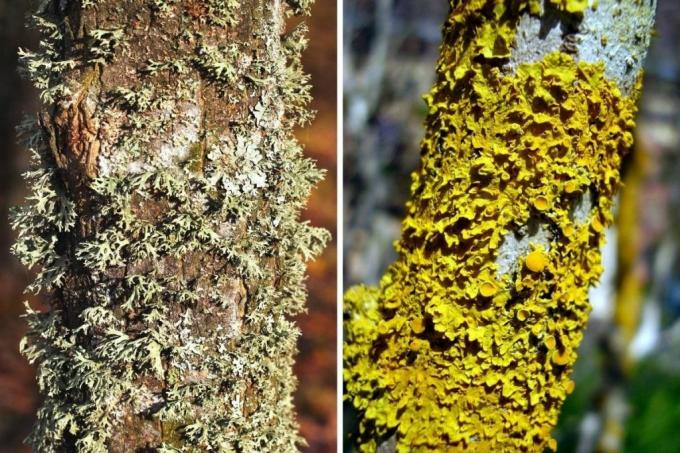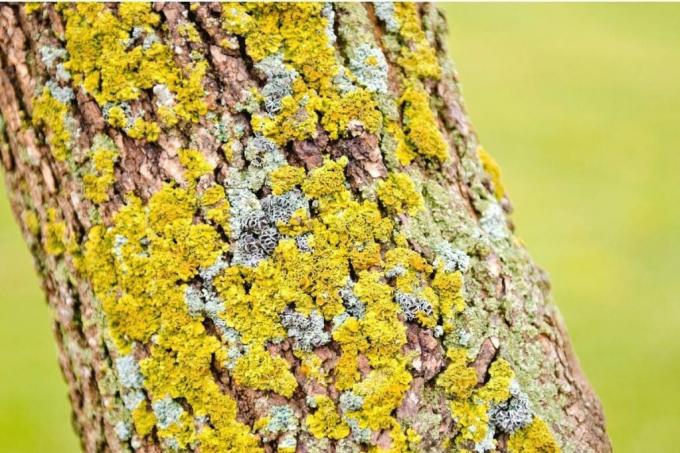
table of contents
- Recognize tree lichens
- Differences from mushrooms
- Lichen on trees
- Remove lichen
- Tree lichen and air quality
- frequently asked Questions
When lichens are first spotted on a tree, there is usually great concern that they are harming the tree in some way. Read here whether tree lichen needs to be removed.
In a nutshell
- there are many different types of lichen
- Creatures of symbiosis from fungi and algae or bacteria
- Completely harmless to trees
- Tree lichens indicate air quality, which is why some species of lichen have become very rare
- can be removed with a brush
Recognize tree lichens
Although there are lichens on trees of different colors, they are all so similar that it is difficult to confuse them with anything else. They are usually green, yellow-green, or blue-gray-green. Lichen is not an independent plant, but a community, which cannot be seen with the naked eye.
Note: Lichen can get very old. 100 years and more are not uncommon.
A fungus forms the basis of the lichen, it adheres to the subsurface, ensures stability and supplies the community with water and minerals. The alga or cyanobacteria cling to the fungus, it benefits from its water uptake and photosynthesis takes place in the community.
Common types of lichen

- Real plum lichen (Evernia prunastri), preference for sloes and plum trees
- Common yellow lichen (Xanthotia parietina) on bark and rocks in agricultural areas
- Key lichen (Parmelia), the last type of lichen in areas with high levels of air pollution
- Lichen (Graphis scripta) on linden, mountain ash or hazelnut
Differences from mushrooms
right one Tree fungi do not just stick to the tree, their root network penetrates the wood and destroys it. In addition, many fungi are putrefactive agents, so they are actually harmful. Only the fruiting body is visible, which has different colors depending on the type of mushroom, but rarely green. Tree fungi are often very hard and difficult to remove from the substrate; the fruiting bodies are often much larger and, above all, thicker than lichens.
Lichen on trees
Since tree lichens seem particularly fond of colonizing older, weakened trees, they are considered pests. This assumption is wrong, however, as they do not penetrate the tree and therefore neither deprive it of nutrients nor cause any damage. Some lichens can settle better on weakened trees because they have fewer antibodies in the bark. Since lichens occur more frequently in locations that they are comfortable with, they can literally overgrow the corresponding trees. This is particularly noticeable in winter, when the leaves of the tree are missing.
Remove lichen
Tree lichen must not and should not be removed, especially not for purely aesthetic reasons. Some species of lichens have become rare due to pollution and require every habitat they can find. There is also protected species.
One reason for removal is general trunk maintenance, in which loose pieces of bark are loosened from the tree so that pests cannot nest underneath. A stiff brush is usually sufficient for this.

Note: Lichen even protects trees as they prevent them from being in place on the bark Colonize harmful organisms.
Tree lichen and air quality
Lichen is an indicator of air quality because it can only absorb its nutrients from the air. The better the air, the more diverse the lichen species that can be found in an area. Conversely, this means that lichen is completely absent in locations with very poor air quality.
frequently asked Questions
In barren areas, lichens serve as food, for example the reindeer lichen for the reindeer, which they themselves can still find under the snow. They also serve as nesting material for birds and even humans use lichens in different areas.
This is completely unnecessary for the lichens and harmful to the environment, even if the lichens grow on stones.
Then there can actually be stunted growth on the tree. In this case, it makes sense to remove the lichens around the buds.
